Biochemistry Diagnostics Report
VerifiedAdded on 2022/10/12
|15
|4415
|144
AI Summary
This report covers the importance of measuring albumin, alpha 1, alpha 2, beta, gamma, plasma creatinine, BUN, PTH, fibrin D-dimer, calcium, plasma thrombin time, osteocalcin, TTG IgA, and eGFR. It also includes a case study on the importance of calcium levels in the body.
Contribute Materials
Your contribution can guide someone’s learning journey. Share your
documents today.

Running head: BIOCHEMISTRY DIAGNOSTICS REPORT 1
Biochemistry Diagnostics Report
Student’s Name
Institutional Affiliation
Biochemistry Diagnostics Report
Student’s Name
Institutional Affiliation
Secure Best Marks with AI Grader
Need help grading? Try our AI Grader for instant feedback on your assignments.
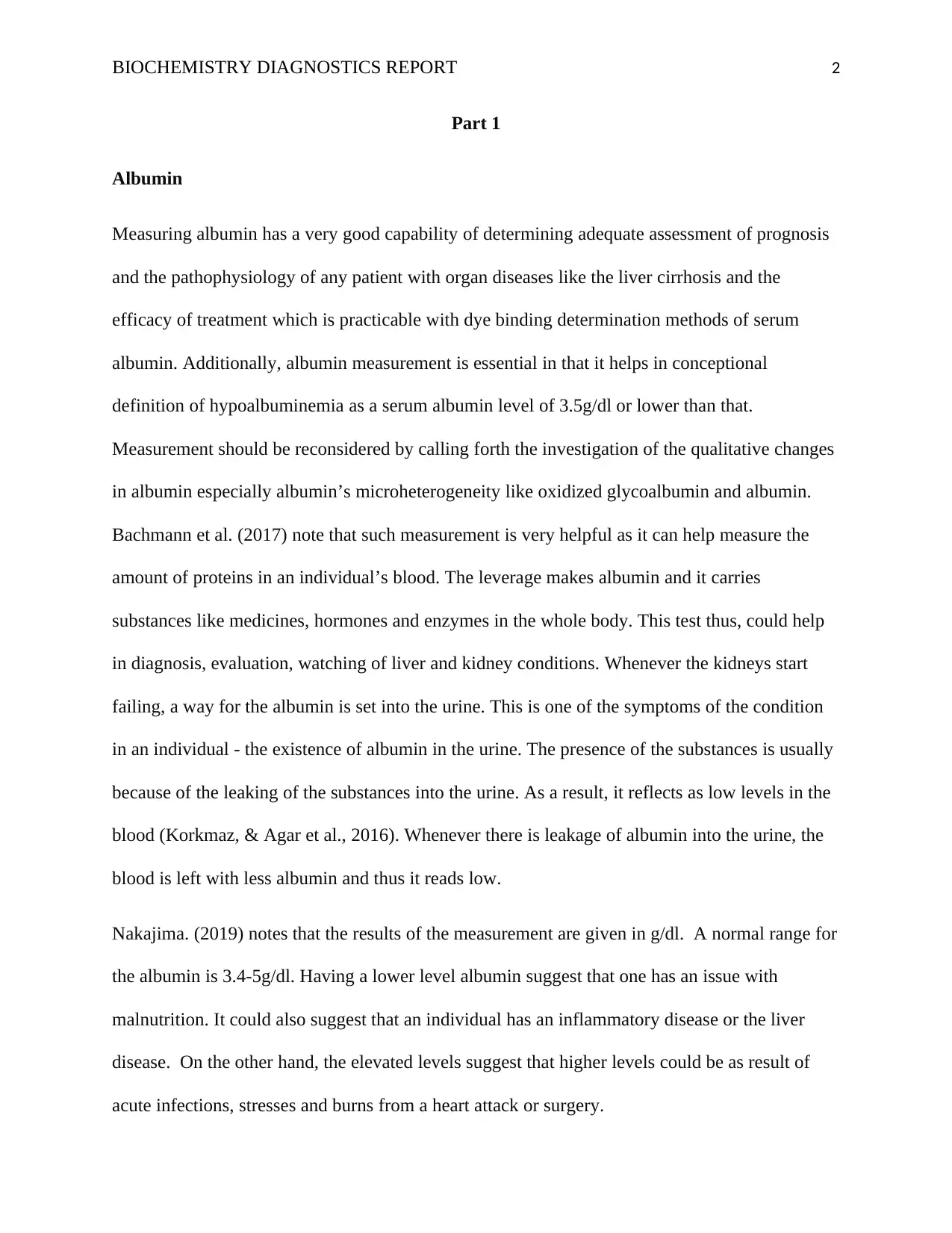
BIOCHEMISTRY DIAGNOSTICS REPORT 2
Part 1
Albumin
Measuring albumin has a very good capability of determining adequate assessment of prognosis
and the pathophysiology of any patient with organ diseases like the liver cirrhosis and the
efficacy of treatment which is practicable with dye binding determination methods of serum
albumin. Additionally, albumin measurement is essential in that it helps in conceptional
definition of hypoalbuminemia as a serum albumin level of 3.5g/dl or lower than that.
Measurement should be reconsidered by calling forth the investigation of the qualitative changes
in albumin especially albumin’s microheterogeneity like oxidized glycoalbumin and albumin.
Bachmann et al. (2017) note that such measurement is very helpful as it can help measure the
amount of proteins in an individual’s blood. The leverage makes albumin and it carries
substances like medicines, hormones and enzymes in the whole body. This test thus, could help
in diagnosis, evaluation, watching of liver and kidney conditions. Whenever the kidneys start
failing, a way for the albumin is set into the urine. This is one of the symptoms of the condition
in an individual - the existence of albumin in the urine. The presence of the substances is usually
because of the leaking of the substances into the urine. As a result, it reflects as low levels in the
blood (Korkmaz, & Agar et al., 2016). Whenever there is leakage of albumin into the urine, the
blood is left with less albumin and thus it reads low.
Nakajima. (2019) notes that the results of the measurement are given in g/dl. A normal range for
the albumin is 3.4-5g/dl. Having a lower level albumin suggest that one has an issue with
malnutrition. It could also suggest that an individual has an inflammatory disease or the liver
disease. On the other hand, the elevated levels suggest that higher levels could be as result of
acute infections, stresses and burns from a heart attack or surgery.
Part 1
Albumin
Measuring albumin has a very good capability of determining adequate assessment of prognosis
and the pathophysiology of any patient with organ diseases like the liver cirrhosis and the
efficacy of treatment which is practicable with dye binding determination methods of serum
albumin. Additionally, albumin measurement is essential in that it helps in conceptional
definition of hypoalbuminemia as a serum albumin level of 3.5g/dl or lower than that.
Measurement should be reconsidered by calling forth the investigation of the qualitative changes
in albumin especially albumin’s microheterogeneity like oxidized glycoalbumin and albumin.
Bachmann et al. (2017) note that such measurement is very helpful as it can help measure the
amount of proteins in an individual’s blood. The leverage makes albumin and it carries
substances like medicines, hormones and enzymes in the whole body. This test thus, could help
in diagnosis, evaluation, watching of liver and kidney conditions. Whenever the kidneys start
failing, a way for the albumin is set into the urine. This is one of the symptoms of the condition
in an individual - the existence of albumin in the urine. The presence of the substances is usually
because of the leaking of the substances into the urine. As a result, it reflects as low levels in the
blood (Korkmaz, & Agar et al., 2016). Whenever there is leakage of albumin into the urine, the
blood is left with less albumin and thus it reads low.
Nakajima. (2019) notes that the results of the measurement are given in g/dl. A normal range for
the albumin is 3.4-5g/dl. Having a lower level albumin suggest that one has an issue with
malnutrition. It could also suggest that an individual has an inflammatory disease or the liver
disease. On the other hand, the elevated levels suggest that higher levels could be as result of
acute infections, stresses and burns from a heart attack or surgery.
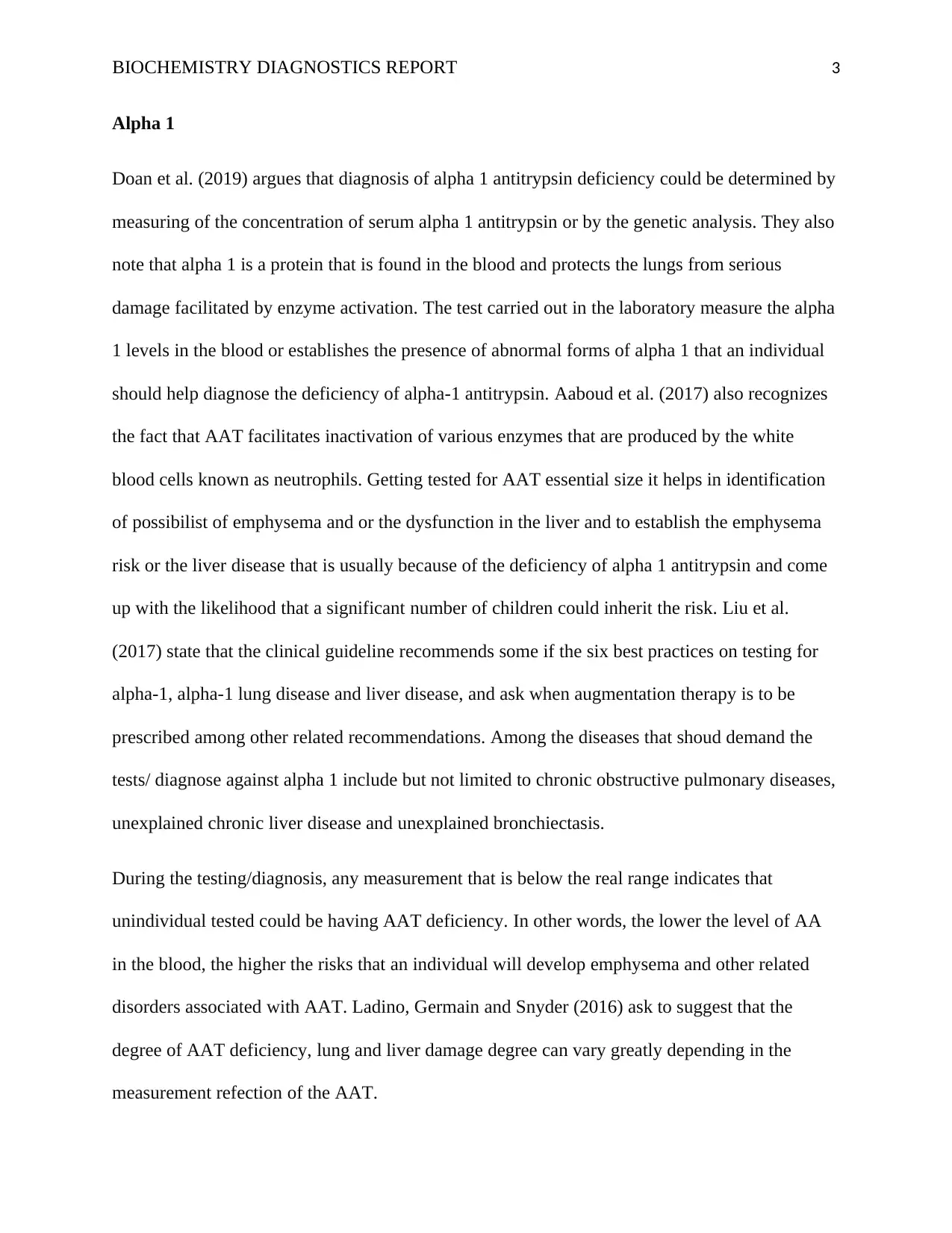
BIOCHEMISTRY DIAGNOSTICS REPORT 3
Alpha 1
Doan et al. (2019) argues that diagnosis of alpha 1 antitrypsin deficiency could be determined by
measuring of the concentration of serum alpha 1 antitrypsin or by the genetic analysis. They also
note that alpha 1 is a protein that is found in the blood and protects the lungs from serious
damage facilitated by enzyme activation. The test carried out in the laboratory measure the alpha
1 levels in the blood or establishes the presence of abnormal forms of alpha 1 that an individual
should help diagnose the deficiency of alpha-1 antitrypsin. Aaboud et al. (2017) also recognizes
the fact that AAT facilitates inactivation of various enzymes that are produced by the white
blood cells known as neutrophils. Getting tested for AAT essential size it helps in identification
of possibilist of emphysema and or the dysfunction in the liver and to establish the emphysema
risk or the liver disease that is usually because of the deficiency of alpha 1 antitrypsin and come
up with the likelihood that a significant number of children could inherit the risk. Liu et al.
(2017) state that the clinical guideline recommends some if the six best practices on testing for
alpha-1, alpha-1 lung disease and liver disease, and ask when augmentation therapy is to be
prescribed among other related recommendations. Among the diseases that shoud demand the
tests/ diagnose against alpha 1 include but not limited to chronic obstructive pulmonary diseases,
unexplained chronic liver disease and unexplained bronchiectasis.
During the testing/diagnosis, any measurement that is below the real range indicates that
unindividual tested could be having AAT deficiency. In other words, the lower the level of AA
in the blood, the higher the risks that an individual will develop emphysema and other related
disorders associated with AAT. Ladino, Germain and Snyder (2016) ask to suggest that the
degree of AAT deficiency, lung and liver damage degree can vary greatly depending in the
measurement refection of the AAT.
Alpha 1
Doan et al. (2019) argues that diagnosis of alpha 1 antitrypsin deficiency could be determined by
measuring of the concentration of serum alpha 1 antitrypsin or by the genetic analysis. They also
note that alpha 1 is a protein that is found in the blood and protects the lungs from serious
damage facilitated by enzyme activation. The test carried out in the laboratory measure the alpha
1 levels in the blood or establishes the presence of abnormal forms of alpha 1 that an individual
should help diagnose the deficiency of alpha-1 antitrypsin. Aaboud et al. (2017) also recognizes
the fact that AAT facilitates inactivation of various enzymes that are produced by the white
blood cells known as neutrophils. Getting tested for AAT essential size it helps in identification
of possibilist of emphysema and or the dysfunction in the liver and to establish the emphysema
risk or the liver disease that is usually because of the deficiency of alpha 1 antitrypsin and come
up with the likelihood that a significant number of children could inherit the risk. Liu et al.
(2017) state that the clinical guideline recommends some if the six best practices on testing for
alpha-1, alpha-1 lung disease and liver disease, and ask when augmentation therapy is to be
prescribed among other related recommendations. Among the diseases that shoud demand the
tests/ diagnose against alpha 1 include but not limited to chronic obstructive pulmonary diseases,
unexplained chronic liver disease and unexplained bronchiectasis.
During the testing/diagnosis, any measurement that is below the real range indicates that
unindividual tested could be having AAT deficiency. In other words, the lower the level of AA
in the blood, the higher the risks that an individual will develop emphysema and other related
disorders associated with AAT. Ladino, Germain and Snyder (2016) ask to suggest that the
degree of AAT deficiency, lung and liver damage degree can vary greatly depending in the
measurement refection of the AAT.
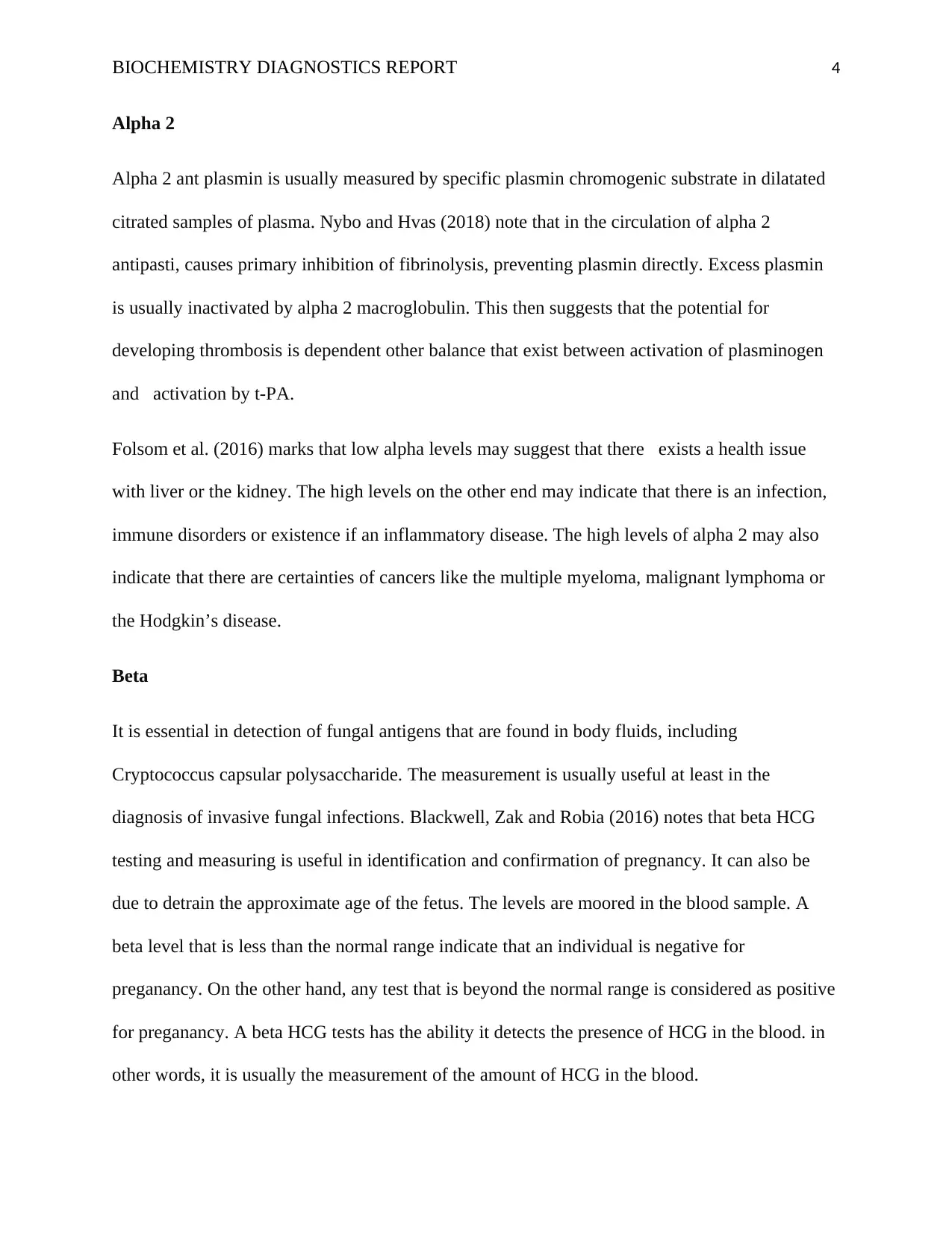
BIOCHEMISTRY DIAGNOSTICS REPORT 4
Alpha 2
Alpha 2 ant plasmin is usually measured by specific plasmin chromogenic substrate in dilatated
citrated samples of plasma. Nybo and Hvas (2018) note that in the circulation of alpha 2
antipasti, causes primary inhibition of fibrinolysis, preventing plasmin directly. Excess plasmin
is usually inactivated by alpha 2 macroglobulin. This then suggests that the potential for
developing thrombosis is dependent other balance that exist between activation of plasminogen
and activation by t-PA.
Folsom et al. (2016) marks that low alpha levels may suggest that there exists a health issue
with liver or the kidney. The high levels on the other end may indicate that there is an infection,
immune disorders or existence if an inflammatory disease. The high levels of alpha 2 may also
indicate that there are certainties of cancers like the multiple myeloma, malignant lymphoma or
the Hodgkin’s disease.
Beta
It is essential in detection of fungal antigens that are found in body fluids, including
Cryptococcus capsular polysaccharide. The measurement is usually useful at least in the
diagnosis of invasive fungal infections. Blackwell, Zak and Robia (2016) notes that beta HCG
testing and measuring is useful in identification and confirmation of pregnancy. It can also be
due to detrain the approximate age of the fetus. The levels are moored in the blood sample. A
beta level that is less than the normal range indicate that an individual is negative for
preganancy. On the other hand, any test that is beyond the normal range is considered as positive
for preganancy. A beta HCG tests has the ability it detects the presence of HCG in the blood. in
other words, it is usually the measurement of the amount of HCG in the blood.
Alpha 2
Alpha 2 ant plasmin is usually measured by specific plasmin chromogenic substrate in dilatated
citrated samples of plasma. Nybo and Hvas (2018) note that in the circulation of alpha 2
antipasti, causes primary inhibition of fibrinolysis, preventing plasmin directly. Excess plasmin
is usually inactivated by alpha 2 macroglobulin. This then suggests that the potential for
developing thrombosis is dependent other balance that exist between activation of plasminogen
and activation by t-PA.
Folsom et al. (2016) marks that low alpha levels may suggest that there exists a health issue
with liver or the kidney. The high levels on the other end may indicate that there is an infection,
immune disorders or existence if an inflammatory disease. The high levels of alpha 2 may also
indicate that there are certainties of cancers like the multiple myeloma, malignant lymphoma or
the Hodgkin’s disease.
Beta
It is essential in detection of fungal antigens that are found in body fluids, including
Cryptococcus capsular polysaccharide. The measurement is usually useful at least in the
diagnosis of invasive fungal infections. Blackwell, Zak and Robia (2016) notes that beta HCG
testing and measuring is useful in identification and confirmation of pregnancy. It can also be
due to detrain the approximate age of the fetus. The levels are moored in the blood sample. A
beta level that is less than the normal range indicate that an individual is negative for
preganancy. On the other hand, any test that is beyond the normal range is considered as positive
for preganancy. A beta HCG tests has the ability it detects the presence of HCG in the blood. in
other words, it is usually the measurement of the amount of HCG in the blood.
Secure Best Marks with AI Grader
Need help grading? Try our AI Grader for instant feedback on your assignments.
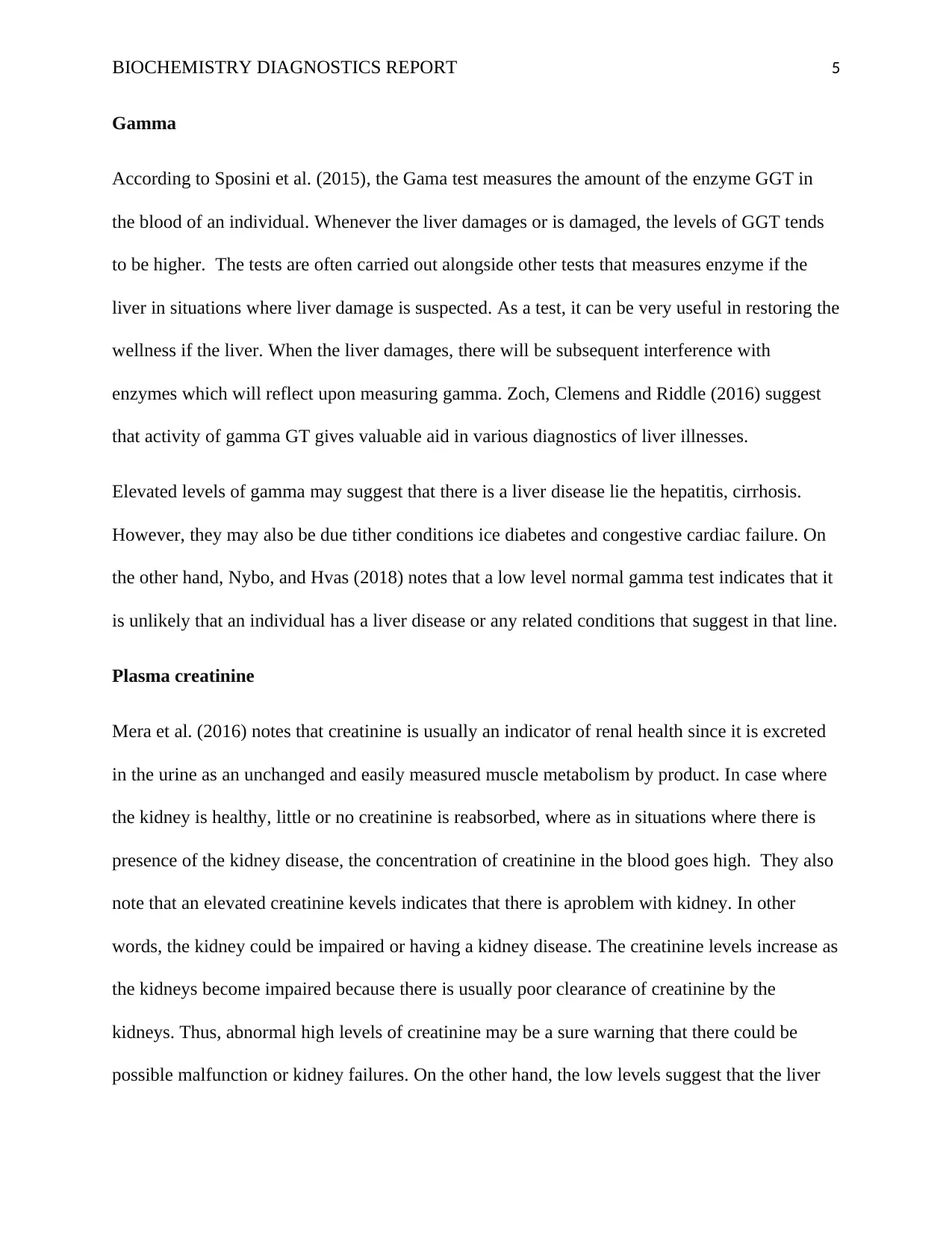
BIOCHEMISTRY DIAGNOSTICS REPORT 5
Gamma
According to Sposini et al. (2015), the Gama test measures the amount of the enzyme GGT in
the blood of an individual. Whenever the liver damages or is damaged, the levels of GGT tends
to be higher. The tests are often carried out alongside other tests that measures enzyme if the
liver in situations where liver damage is suspected. As a test, it can be very useful in restoring the
wellness if the liver. When the liver damages, there will be subsequent interference with
enzymes which will reflect upon measuring gamma. Zoch, Clemens and Riddle (2016) suggest
that activity of gamma GT gives valuable aid in various diagnostics of liver illnesses.
Elevated levels of gamma may suggest that there is a liver disease lie the hepatitis, cirrhosis.
However, they may also be due tither conditions ice diabetes and congestive cardiac failure. On
the other hand, Nybo, and Hvas (2018) notes that a low level normal gamma test indicates that it
is unlikely that an individual has a liver disease or any related conditions that suggest in that line.
Plasma creatinine
Mera et al. (2016) notes that creatinine is usually an indicator of renal health since it is excreted
in the urine as an unchanged and easily measured muscle metabolism by product. In case where
the kidney is healthy, little or no creatinine is reabsorbed, where as in situations where there is
presence of the kidney disease, the concentration of creatinine in the blood goes high. They also
note that an elevated creatinine kevels indicates that there is aproblem with kidney. In other
words, the kidney could be impaired or having a kidney disease. The creatinine levels increase as
the kidneys become impaired because there is usually poor clearance of creatinine by the
kidneys. Thus, abnormal high levels of creatinine may be a sure warning that there could be
possible malfunction or kidney failures. On the other hand, the low levels suggest that the liver
Gamma
According to Sposini et al. (2015), the Gama test measures the amount of the enzyme GGT in
the blood of an individual. Whenever the liver damages or is damaged, the levels of GGT tends
to be higher. The tests are often carried out alongside other tests that measures enzyme if the
liver in situations where liver damage is suspected. As a test, it can be very useful in restoring the
wellness if the liver. When the liver damages, there will be subsequent interference with
enzymes which will reflect upon measuring gamma. Zoch, Clemens and Riddle (2016) suggest
that activity of gamma GT gives valuable aid in various diagnostics of liver illnesses.
Elevated levels of gamma may suggest that there is a liver disease lie the hepatitis, cirrhosis.
However, they may also be due tither conditions ice diabetes and congestive cardiac failure. On
the other hand, Nybo, and Hvas (2018) notes that a low level normal gamma test indicates that it
is unlikely that an individual has a liver disease or any related conditions that suggest in that line.
Plasma creatinine
Mera et al. (2016) notes that creatinine is usually an indicator of renal health since it is excreted
in the urine as an unchanged and easily measured muscle metabolism by product. In case where
the kidney is healthy, little or no creatinine is reabsorbed, where as in situations where there is
presence of the kidney disease, the concentration of creatinine in the blood goes high. They also
note that an elevated creatinine kevels indicates that there is aproblem with kidney. In other
words, the kidney could be impaired or having a kidney disease. The creatinine levels increase as
the kidneys become impaired because there is usually poor clearance of creatinine by the
kidneys. Thus, abnormal high levels of creatinine may be a sure warning that there could be
possible malfunction or kidney failures. On the other hand, the low levels suggest that the liver
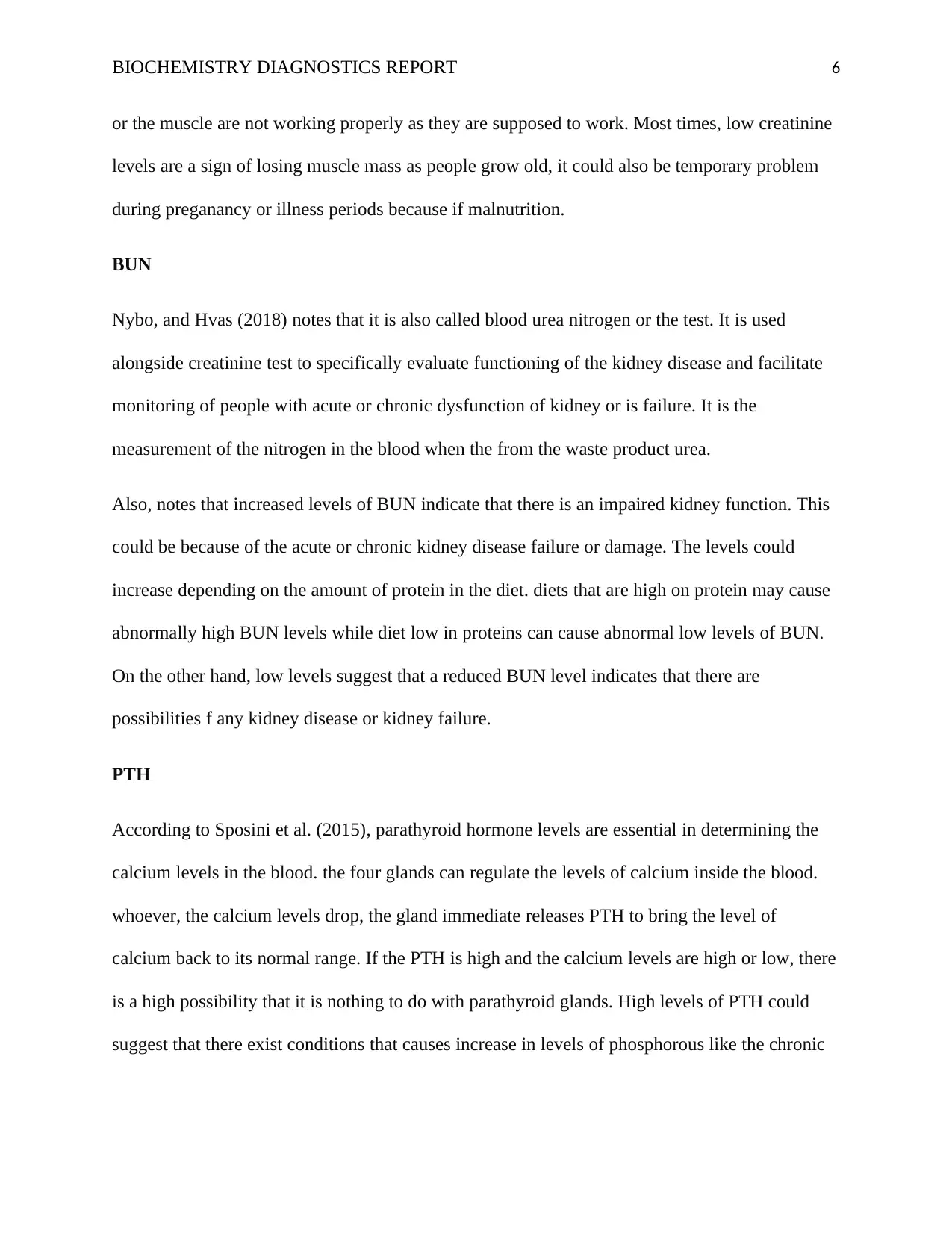
BIOCHEMISTRY DIAGNOSTICS REPORT 6
or the muscle are not working properly as they are supposed to work. Most times, low creatinine
levels are a sign of losing muscle mass as people grow old, it could also be temporary problem
during preganancy or illness periods because if malnutrition.
BUN
Nybo, and Hvas (2018) notes that it is also called blood urea nitrogen or the test. It is used
alongside creatinine test to specifically evaluate functioning of the kidney disease and facilitate
monitoring of people with acute or chronic dysfunction of kidney or is failure. It is the
measurement of the nitrogen in the blood when the from the waste product urea.
Also, notes that increased levels of BUN indicate that there is an impaired kidney function. This
could be because of the acute or chronic kidney disease failure or damage. The levels could
increase depending on the amount of protein in the diet. diets that are high on protein may cause
abnormally high BUN levels while diet low in proteins can cause abnormal low levels of BUN.
On the other hand, low levels suggest that a reduced BUN level indicates that there are
possibilities f any kidney disease or kidney failure.
PTH
According to Sposini et al. (2015), parathyroid hormone levels are essential in determining the
calcium levels in the blood. the four glands can regulate the levels of calcium inside the blood.
whoever, the calcium levels drop, the gland immediate releases PTH to bring the level of
calcium back to its normal range. If the PTH is high and the calcium levels are high or low, there
is a high possibility that it is nothing to do with parathyroid glands. High levels of PTH could
suggest that there exist conditions that causes increase in levels of phosphorous like the chronic
or the muscle are not working properly as they are supposed to work. Most times, low creatinine
levels are a sign of losing muscle mass as people grow old, it could also be temporary problem
during preganancy or illness periods because if malnutrition.
BUN
Nybo, and Hvas (2018) notes that it is also called blood urea nitrogen or the test. It is used
alongside creatinine test to specifically evaluate functioning of the kidney disease and facilitate
monitoring of people with acute or chronic dysfunction of kidney or is failure. It is the
measurement of the nitrogen in the blood when the from the waste product urea.
Also, notes that increased levels of BUN indicate that there is an impaired kidney function. This
could be because of the acute or chronic kidney disease failure or damage. The levels could
increase depending on the amount of protein in the diet. diets that are high on protein may cause
abnormally high BUN levels while diet low in proteins can cause abnormal low levels of BUN.
On the other hand, low levels suggest that a reduced BUN level indicates that there are
possibilities f any kidney disease or kidney failure.
PTH
According to Sposini et al. (2015), parathyroid hormone levels are essential in determining the
calcium levels in the blood. the four glands can regulate the levels of calcium inside the blood.
whoever, the calcium levels drop, the gland immediate releases PTH to bring the level of
calcium back to its normal range. If the PTH is high and the calcium levels are high or low, there
is a high possibility that it is nothing to do with parathyroid glands. High levels of PTH could
suggest that there exist conditions that causes increase in levels of phosphorous like the chronic
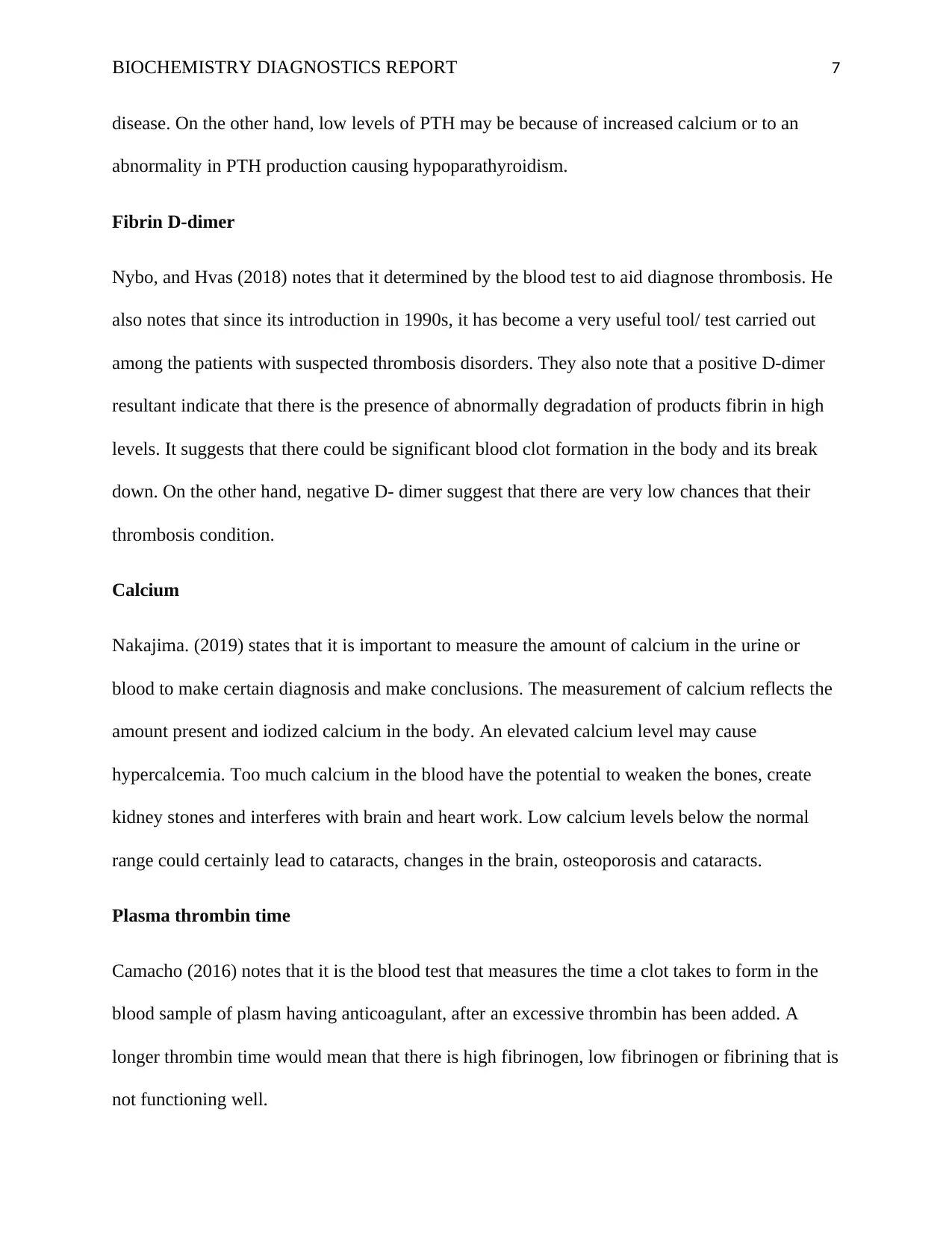
BIOCHEMISTRY DIAGNOSTICS REPORT 7
disease. On the other hand, low levels of PTH may be because of increased calcium or to an
abnormality in PTH production causing hypoparathyroidism.
Fibrin D-dimer
Nybo, and Hvas (2018) notes that it determined by the blood test to aid diagnose thrombosis. He
also notes that since its introduction in 1990s, it has become a very useful tool/ test carried out
among the patients with suspected thrombosis disorders. They also note that a positive D-dimer
resultant indicate that there is the presence of abnormally degradation of products fibrin in high
levels. It suggests that there could be significant blood clot formation in the body and its break
down. On the other hand, negative D- dimer suggest that there are very low chances that their
thrombosis condition.
Calcium
Nakajima. (2019) states that it is important to measure the amount of calcium in the urine or
blood to make certain diagnosis and make conclusions. The measurement of calcium reflects the
amount present and iodized calcium in the body. An elevated calcium level may cause
hypercalcemia. Too much calcium in the blood have the potential to weaken the bones, create
kidney stones and interferes with brain and heart work. Low calcium levels below the normal
range could certainly lead to cataracts, changes in the brain, osteoporosis and cataracts.
Plasma thrombin time
Camacho (2016) notes that it is the blood test that measures the time a clot takes to form in the
blood sample of plasm having anticoagulant, after an excessive thrombin has been added. A
longer thrombin time would mean that there is high fibrinogen, low fibrinogen or fibrining that is
not functioning well.
disease. On the other hand, low levels of PTH may be because of increased calcium or to an
abnormality in PTH production causing hypoparathyroidism.
Fibrin D-dimer
Nybo, and Hvas (2018) notes that it determined by the blood test to aid diagnose thrombosis. He
also notes that since its introduction in 1990s, it has become a very useful tool/ test carried out
among the patients with suspected thrombosis disorders. They also note that a positive D-dimer
resultant indicate that there is the presence of abnormally degradation of products fibrin in high
levels. It suggests that there could be significant blood clot formation in the body and its break
down. On the other hand, negative D- dimer suggest that there are very low chances that their
thrombosis condition.
Calcium
Nakajima. (2019) states that it is important to measure the amount of calcium in the urine or
blood to make certain diagnosis and make conclusions. The measurement of calcium reflects the
amount present and iodized calcium in the body. An elevated calcium level may cause
hypercalcemia. Too much calcium in the blood have the potential to weaken the bones, create
kidney stones and interferes with brain and heart work. Low calcium levels below the normal
range could certainly lead to cataracts, changes in the brain, osteoporosis and cataracts.
Plasma thrombin time
Camacho (2016) notes that it is the blood test that measures the time a clot takes to form in the
blood sample of plasm having anticoagulant, after an excessive thrombin has been added. A
longer thrombin time would mean that there is high fibrinogen, low fibrinogen or fibrining that is
not functioning well.
Paraphrase This Document
Need a fresh take? Get an instant paraphrase of this document with our AI Paraphraser
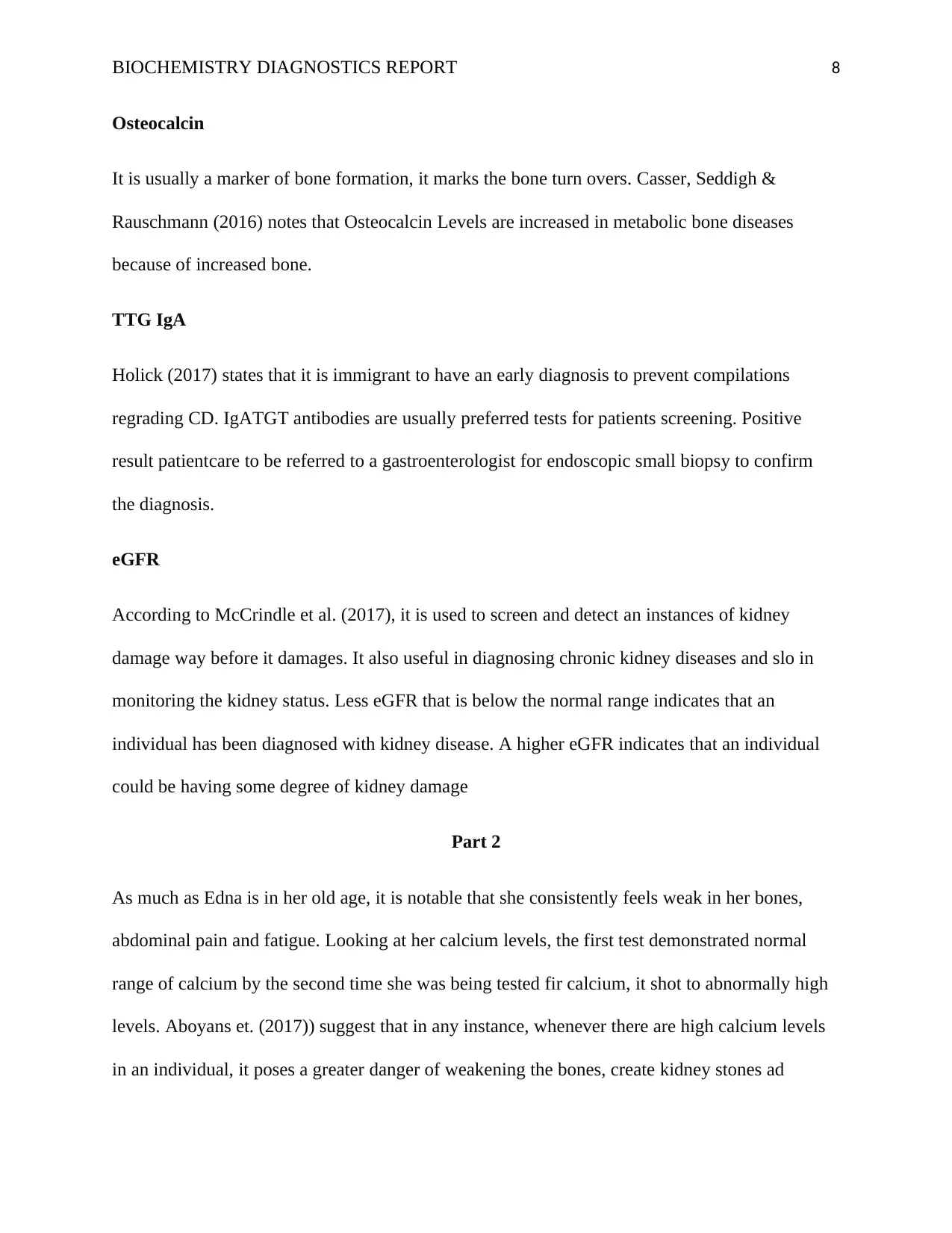
BIOCHEMISTRY DIAGNOSTICS REPORT 8
Osteocalcin
It is usually a marker of bone formation, it marks the bone turn overs. Casser, Seddigh &
Rauschmann (2016) notes that Osteocalcin Levels are increased in metabolic bone diseases
because of increased bone.
TTG IgA
Holick (2017) states that it is immigrant to have an early diagnosis to prevent compilations
regrading CD. IgATGT antibodies are usually preferred tests for patients screening. Positive
result patientcare to be referred to a gastroenterologist for endoscopic small biopsy to confirm
the diagnosis.
eGFR
According to McCrindle et al. (2017), it is used to screen and detect an instances of kidney
damage way before it damages. It also useful in diagnosing chronic kidney diseases and slo in
monitoring the kidney status. Less eGFR that is below the normal range indicates that an
individual has been diagnosed with kidney disease. A higher eGFR indicates that an individual
could be having some degree of kidney damage
Part 2
As much as Edna is in her old age, it is notable that she consistently feels weak in her bones,
abdominal pain and fatigue. Looking at her calcium levels, the first test demonstrated normal
range of calcium by the second time she was being tested fir calcium, it shot to abnormally high
levels. Aboyans et. (2017)) suggest that in any instance, whenever there are high calcium levels
in an individual, it poses a greater danger of weakening the bones, create kidney stones ad
Osteocalcin
It is usually a marker of bone formation, it marks the bone turn overs. Casser, Seddigh &
Rauschmann (2016) notes that Osteocalcin Levels are increased in metabolic bone diseases
because of increased bone.
TTG IgA
Holick (2017) states that it is immigrant to have an early diagnosis to prevent compilations
regrading CD. IgATGT antibodies are usually preferred tests for patients screening. Positive
result patientcare to be referred to a gastroenterologist for endoscopic small biopsy to confirm
the diagnosis.
eGFR
According to McCrindle et al. (2017), it is used to screen and detect an instances of kidney
damage way before it damages. It also useful in diagnosing chronic kidney diseases and slo in
monitoring the kidney status. Less eGFR that is below the normal range indicates that an
individual has been diagnosed with kidney disease. A higher eGFR indicates that an individual
could be having some degree of kidney damage
Part 2
As much as Edna is in her old age, it is notable that she consistently feels weak in her bones,
abdominal pain and fatigue. Looking at her calcium levels, the first test demonstrated normal
range of calcium by the second time she was being tested fir calcium, it shot to abnormally high
levels. Aboyans et. (2017)) suggest that in any instance, whenever there are high calcium levels
in an individual, it poses a greater danger of weakening the bones, create kidney stones ad
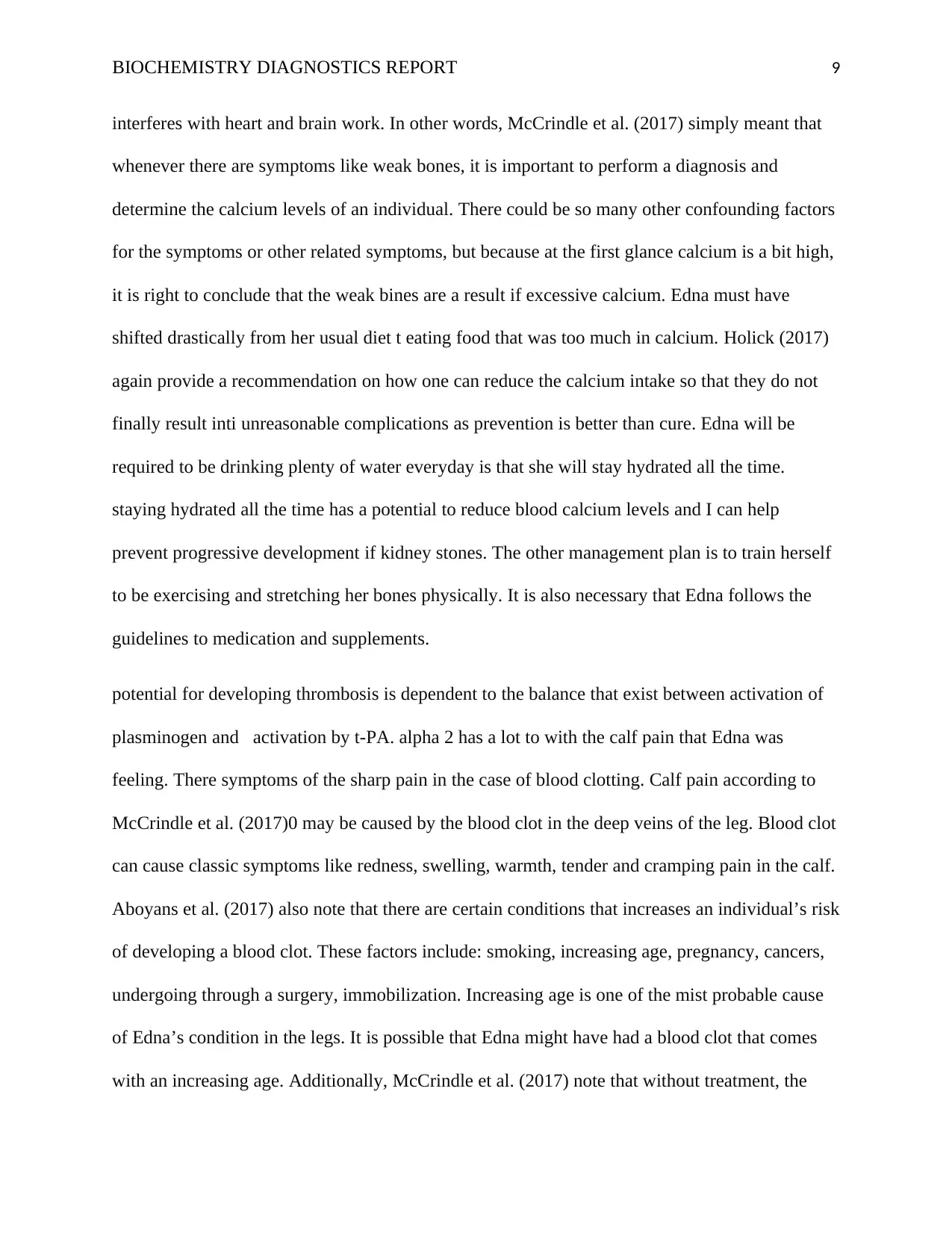
BIOCHEMISTRY DIAGNOSTICS REPORT 9
interferes with heart and brain work. In other words, McCrindle et al. (2017) simply meant that
whenever there are symptoms like weak bones, it is important to perform a diagnosis and
determine the calcium levels of an individual. There could be so many other confounding factors
for the symptoms or other related symptoms, but because at the first glance calcium is a bit high,
it is right to conclude that the weak bines are a result if excessive calcium. Edna must have
shifted drastically from her usual diet t eating food that was too much in calcium. Holick (2017)
again provide a recommendation on how one can reduce the calcium intake so that they do not
finally result inti unreasonable complications as prevention is better than cure. Edna will be
required to be drinking plenty of water everyday is that she will stay hydrated all the time.
staying hydrated all the time has a potential to reduce blood calcium levels and I can help
prevent progressive development if kidney stones. The other management plan is to train herself
to be exercising and stretching her bones physically. It is also necessary that Edna follows the
guidelines to medication and supplements.
potential for developing thrombosis is dependent to the balance that exist between activation of
plasminogen and activation by t-PA. alpha 2 has a lot to with the calf pain that Edna was
feeling. There symptoms of the sharp pain in the case of blood clotting. Calf pain according to
McCrindle et al. (2017)0 may be caused by the blood clot in the deep veins of the leg. Blood clot
can cause classic symptoms like redness, swelling, warmth, tender and cramping pain in the calf.
Aboyans et al. (2017) also note that there are certain conditions that increases an individual’s risk
of developing a blood clot. These factors include: smoking, increasing age, pregnancy, cancers,
undergoing through a surgery, immobilization. Increasing age is one of the mist probable cause
of Edna’s condition in the legs. It is possible that Edna might have had a blood clot that comes
with an increasing age. Additionally, McCrindle et al. (2017) note that without treatment, the
interferes with heart and brain work. In other words, McCrindle et al. (2017) simply meant that
whenever there are symptoms like weak bones, it is important to perform a diagnosis and
determine the calcium levels of an individual. There could be so many other confounding factors
for the symptoms or other related symptoms, but because at the first glance calcium is a bit high,
it is right to conclude that the weak bines are a result if excessive calcium. Edna must have
shifted drastically from her usual diet t eating food that was too much in calcium. Holick (2017)
again provide a recommendation on how one can reduce the calcium intake so that they do not
finally result inti unreasonable complications as prevention is better than cure. Edna will be
required to be drinking plenty of water everyday is that she will stay hydrated all the time.
staying hydrated all the time has a potential to reduce blood calcium levels and I can help
prevent progressive development if kidney stones. The other management plan is to train herself
to be exercising and stretching her bones physically. It is also necessary that Edna follows the
guidelines to medication and supplements.
potential for developing thrombosis is dependent to the balance that exist between activation of
plasminogen and activation by t-PA. alpha 2 has a lot to with the calf pain that Edna was
feeling. There symptoms of the sharp pain in the case of blood clotting. Calf pain according to
McCrindle et al. (2017)0 may be caused by the blood clot in the deep veins of the leg. Blood clot
can cause classic symptoms like redness, swelling, warmth, tender and cramping pain in the calf.
Aboyans et al. (2017) also note that there are certain conditions that increases an individual’s risk
of developing a blood clot. These factors include: smoking, increasing age, pregnancy, cancers,
undergoing through a surgery, immobilization. Increasing age is one of the mist probable cause
of Edna’s condition in the legs. It is possible that Edna might have had a blood clot that comes
with an increasing age. Additionally, McCrindle et al. (2017) note that without treatment, the
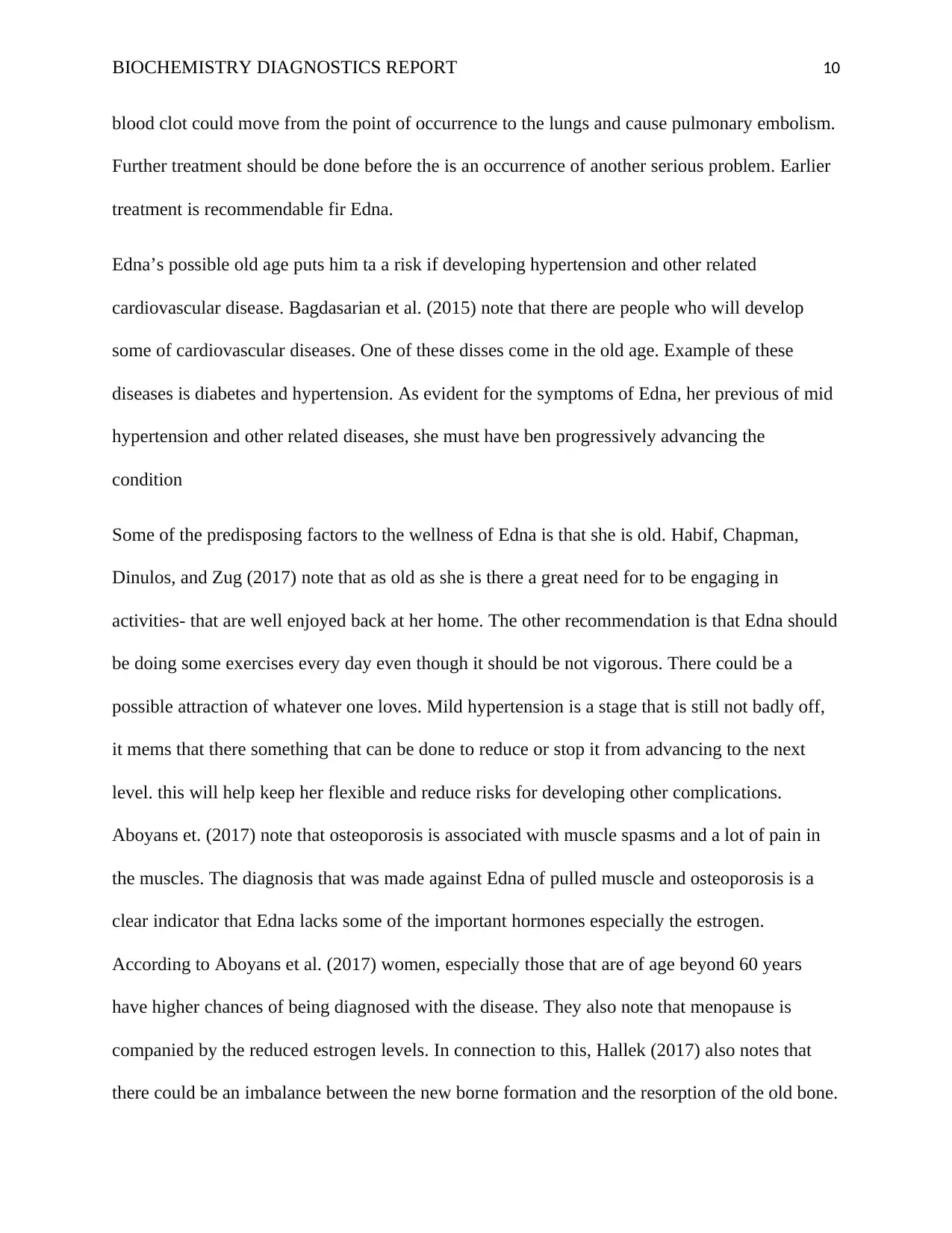
BIOCHEMISTRY DIAGNOSTICS REPORT 10
blood clot could move from the point of occurrence to the lungs and cause pulmonary embolism.
Further treatment should be done before the is an occurrence of another serious problem. Earlier
treatment is recommendable fir Edna.
Edna’s possible old age puts him ta a risk if developing hypertension and other related
cardiovascular disease. Bagdasarian et al. (2015) note that there are people who will develop
some of cardiovascular diseases. One of these disses come in the old age. Example of these
diseases is diabetes and hypertension. As evident for the symptoms of Edna, her previous of mid
hypertension and other related diseases, she must have ben progressively advancing the
condition
Some of the predisposing factors to the wellness of Edna is that she is old. Habif, Chapman,
Dinulos, and Zug (2017) note that as old as she is there a great need for to be engaging in
activities- that are well enjoyed back at her home. The other recommendation is that Edna should
be doing some exercises every day even though it should be not vigorous. There could be a
possible attraction of whatever one loves. Mild hypertension is a stage that is still not badly off,
it mems that there something that can be done to reduce or stop it from advancing to the next
level. this will help keep her flexible and reduce risks for developing other complications.
Aboyans et. (2017) note that osteoporosis is associated with muscle spasms and a lot of pain in
the muscles. The diagnosis that was made against Edna of pulled muscle and osteoporosis is a
clear indicator that Edna lacks some of the important hormones especially the estrogen.
According to Aboyans et al. (2017) women, especially those that are of age beyond 60 years
have higher chances of being diagnosed with the disease. They also note that menopause is
companied by the reduced estrogen levels. In connection to this, Hallek (2017) also notes that
there could be an imbalance between the new borne formation and the resorption of the old bone.
blood clot could move from the point of occurrence to the lungs and cause pulmonary embolism.
Further treatment should be done before the is an occurrence of another serious problem. Earlier
treatment is recommendable fir Edna.
Edna’s possible old age puts him ta a risk if developing hypertension and other related
cardiovascular disease. Bagdasarian et al. (2015) note that there are people who will develop
some of cardiovascular diseases. One of these disses come in the old age. Example of these
diseases is diabetes and hypertension. As evident for the symptoms of Edna, her previous of mid
hypertension and other related diseases, she must have ben progressively advancing the
condition
Some of the predisposing factors to the wellness of Edna is that she is old. Habif, Chapman,
Dinulos, and Zug (2017) note that as old as she is there a great need for to be engaging in
activities- that are well enjoyed back at her home. The other recommendation is that Edna should
be doing some exercises every day even though it should be not vigorous. There could be a
possible attraction of whatever one loves. Mild hypertension is a stage that is still not badly off,
it mems that there something that can be done to reduce or stop it from advancing to the next
level. this will help keep her flexible and reduce risks for developing other complications.
Aboyans et. (2017) note that osteoporosis is associated with muscle spasms and a lot of pain in
the muscles. The diagnosis that was made against Edna of pulled muscle and osteoporosis is a
clear indicator that Edna lacks some of the important hormones especially the estrogen.
According to Aboyans et al. (2017) women, especially those that are of age beyond 60 years
have higher chances of being diagnosed with the disease. They also note that menopause is
companied by the reduced estrogen levels. In connection to this, Hallek (2017) also notes that
there could be an imbalance between the new borne formation and the resorption of the old bone.
Secure Best Marks with AI Grader
Need help grading? Try our AI Grader for instant feedback on your assignments.
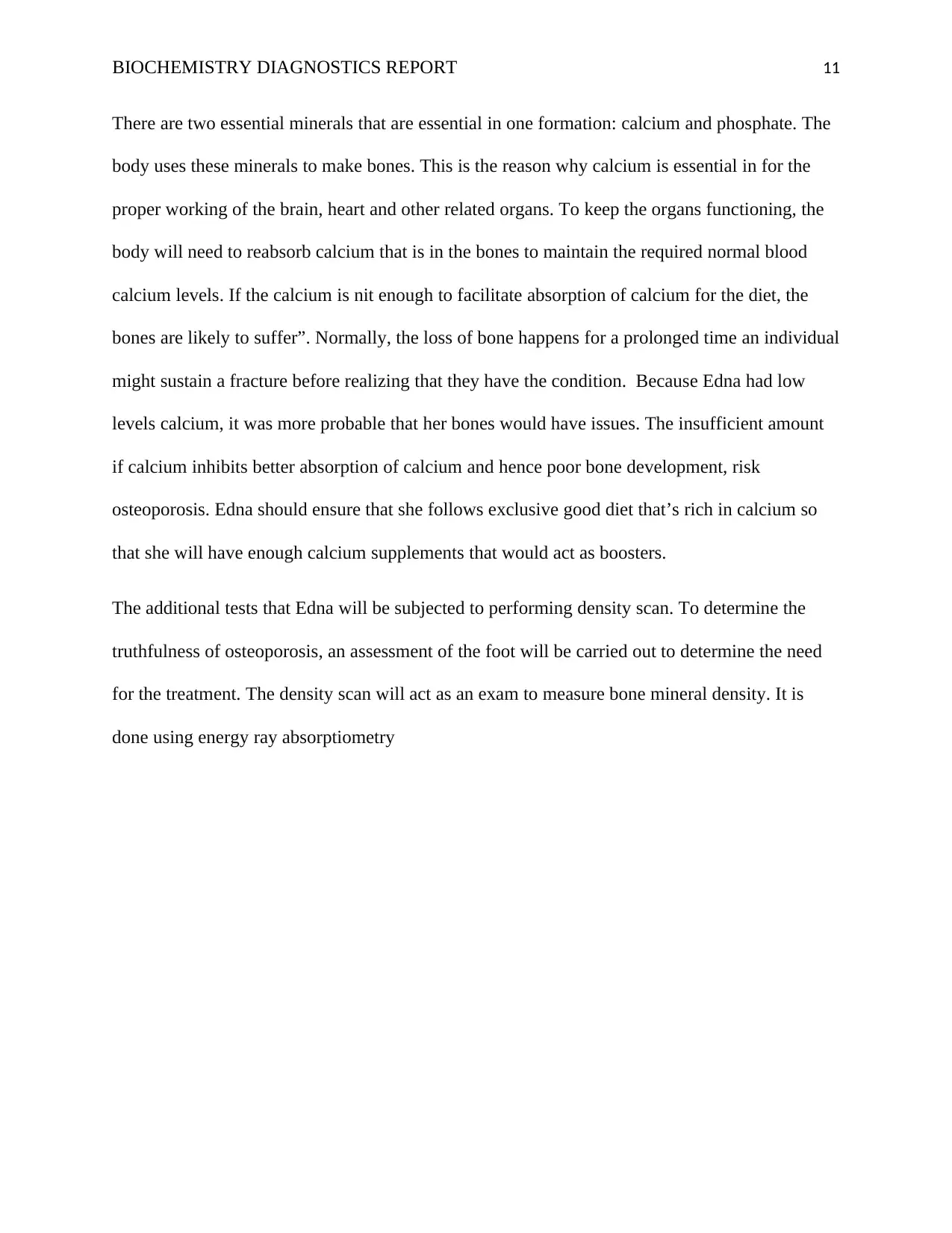
BIOCHEMISTRY DIAGNOSTICS REPORT 11
There are two essential minerals that are essential in one formation: calcium and phosphate. The
body uses these minerals to make bones. This is the reason why calcium is essential in for the
proper working of the brain, heart and other related organs. To keep the organs functioning, the
body will need to reabsorb calcium that is in the bones to maintain the required normal blood
calcium levels. If the calcium is nit enough to facilitate absorption of calcium for the diet, the
bones are likely to suffer”. Normally, the loss of bone happens for a prolonged time an individual
might sustain a fracture before realizing that they have the condition. Because Edna had low
levels calcium, it was more probable that her bones would have issues. The insufficient amount
if calcium inhibits better absorption of calcium and hence poor bone development, risk
osteoporosis. Edna should ensure that she follows exclusive good diet that’s rich in calcium so
that she will have enough calcium supplements that would act as boosters.
The additional tests that Edna will be subjected to performing density scan. To determine the
truthfulness of osteoporosis, an assessment of the foot will be carried out to determine the need
for the treatment. The density scan will act as an exam to measure bone mineral density. It is
done using energy ray absorptiometry
There are two essential minerals that are essential in one formation: calcium and phosphate. The
body uses these minerals to make bones. This is the reason why calcium is essential in for the
proper working of the brain, heart and other related organs. To keep the organs functioning, the
body will need to reabsorb calcium that is in the bones to maintain the required normal blood
calcium levels. If the calcium is nit enough to facilitate absorption of calcium for the diet, the
bones are likely to suffer”. Normally, the loss of bone happens for a prolonged time an individual
might sustain a fracture before realizing that they have the condition. Because Edna had low
levels calcium, it was more probable that her bones would have issues. The insufficient amount
if calcium inhibits better absorption of calcium and hence poor bone development, risk
osteoporosis. Edna should ensure that she follows exclusive good diet that’s rich in calcium so
that she will have enough calcium supplements that would act as boosters.
The additional tests that Edna will be subjected to performing density scan. To determine the
truthfulness of osteoporosis, an assessment of the foot will be carried out to determine the need
for the treatment. The density scan will act as an exam to measure bone mineral density. It is
done using energy ray absorptiometry
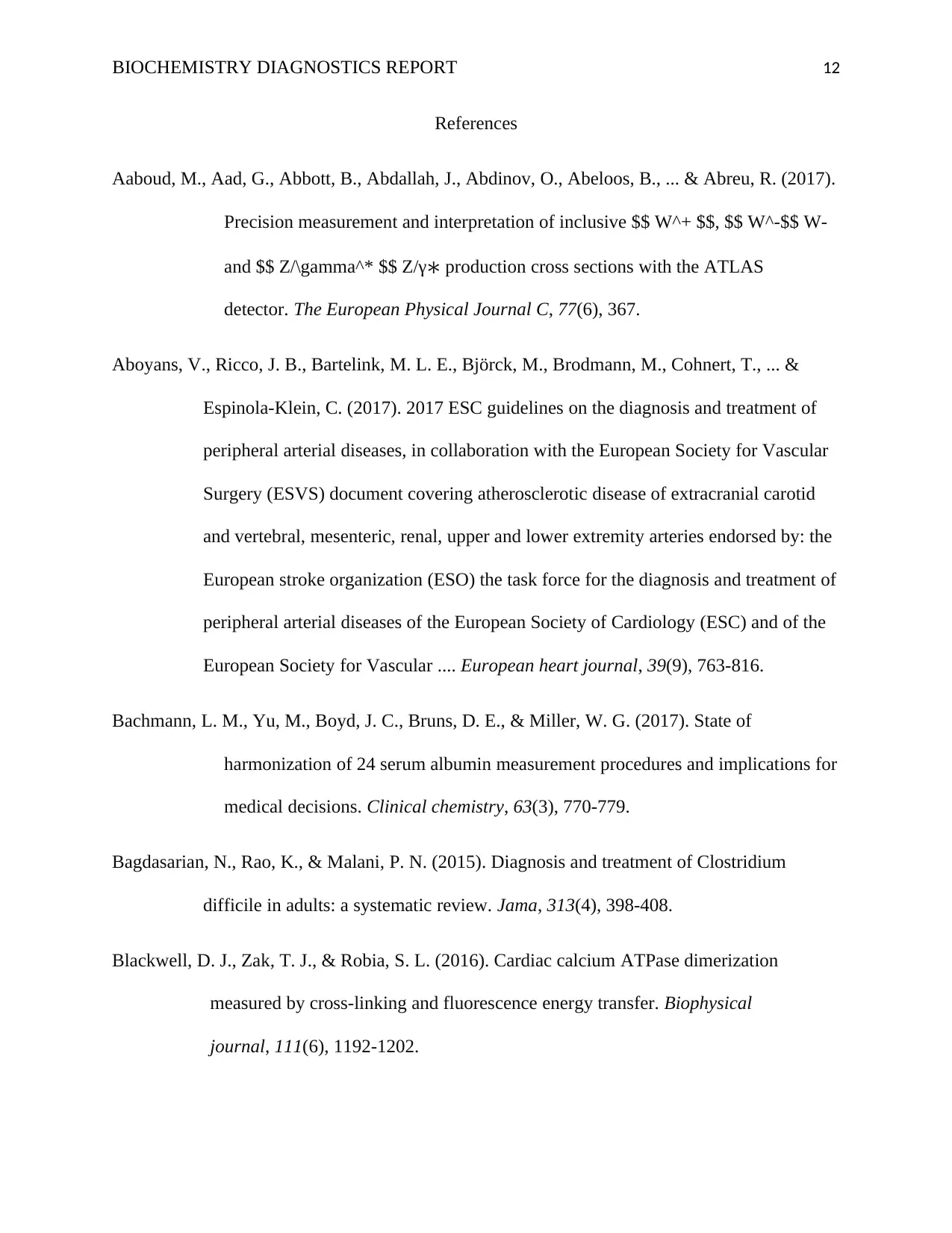
BIOCHEMISTRY DIAGNOSTICS REPORT 12
References
Aaboud, M., Aad, G., Abbott, B., Abdallah, J., Abdinov, O., Abeloos, B., ... & Abreu, R. (2017).
Precision measurement and interpretation of inclusive $$ W^+ $$, $$ W^-$$ W-
and $$ Z/\gamma^* $$ Z/γ∗ production cross sections with the ATLAS
detector. The European Physical Journal C, 77(6), 367.
Aboyans, V., Ricco, J. B., Bartelink, M. L. E., Björck, M., Brodmann, M., Cohnert, T., ... &
Espinola-Klein, C. (2017). 2017 ESC guidelines on the diagnosis and treatment of
peripheral arterial diseases, in collaboration with the European Society for Vascular
Surgery (ESVS) document covering atherosclerotic disease of extracranial carotid
and vertebral, mesenteric, renal, upper and lower extremity arteries endorsed by: the
European stroke organization (ESO) the task force for the diagnosis and treatment of
peripheral arterial diseases of the European Society of Cardiology (ESC) and of the
European Society for Vascular .... European heart journal, 39(9), 763-816.
Bachmann, L. M., Yu, M., Boyd, J. C., Bruns, D. E., & Miller, W. G. (2017). State of
harmonization of 24 serum albumin measurement procedures and implications for
medical decisions. Clinical chemistry, 63(3), 770-779.
Bagdasarian, N., Rao, K., & Malani, P. N. (2015). Diagnosis and treatment of Clostridium
difficile in adults: a systematic review. Jama, 313(4), 398-408.
Blackwell, D. J., Zak, T. J., & Robia, S. L. (2016). Cardiac calcium ATPase dimerization
measured by cross-linking and fluorescence energy transfer. Biophysical
journal, 111(6), 1192-1202.
References
Aaboud, M., Aad, G., Abbott, B., Abdallah, J., Abdinov, O., Abeloos, B., ... & Abreu, R. (2017).
Precision measurement and interpretation of inclusive $$ W^+ $$, $$ W^-$$ W-
and $$ Z/\gamma^* $$ Z/γ∗ production cross sections with the ATLAS
detector. The European Physical Journal C, 77(6), 367.
Aboyans, V., Ricco, J. B., Bartelink, M. L. E., Björck, M., Brodmann, M., Cohnert, T., ... &
Espinola-Klein, C. (2017). 2017 ESC guidelines on the diagnosis and treatment of
peripheral arterial diseases, in collaboration with the European Society for Vascular
Surgery (ESVS) document covering atherosclerotic disease of extracranial carotid
and vertebral, mesenteric, renal, upper and lower extremity arteries endorsed by: the
European stroke organization (ESO) the task force for the diagnosis and treatment of
peripheral arterial diseases of the European Society of Cardiology (ESC) and of the
European Society for Vascular .... European heart journal, 39(9), 763-816.
Bachmann, L. M., Yu, M., Boyd, J. C., Bruns, D. E., & Miller, W. G. (2017). State of
harmonization of 24 serum albumin measurement procedures and implications for
medical decisions. Clinical chemistry, 63(3), 770-779.
Bagdasarian, N., Rao, K., & Malani, P. N. (2015). Diagnosis and treatment of Clostridium
difficile in adults: a systematic review. Jama, 313(4), 398-408.
Blackwell, D. J., Zak, T. J., & Robia, S. L. (2016). Cardiac calcium ATPase dimerization
measured by cross-linking and fluorescence energy transfer. Biophysical
journal, 111(6), 1192-1202.
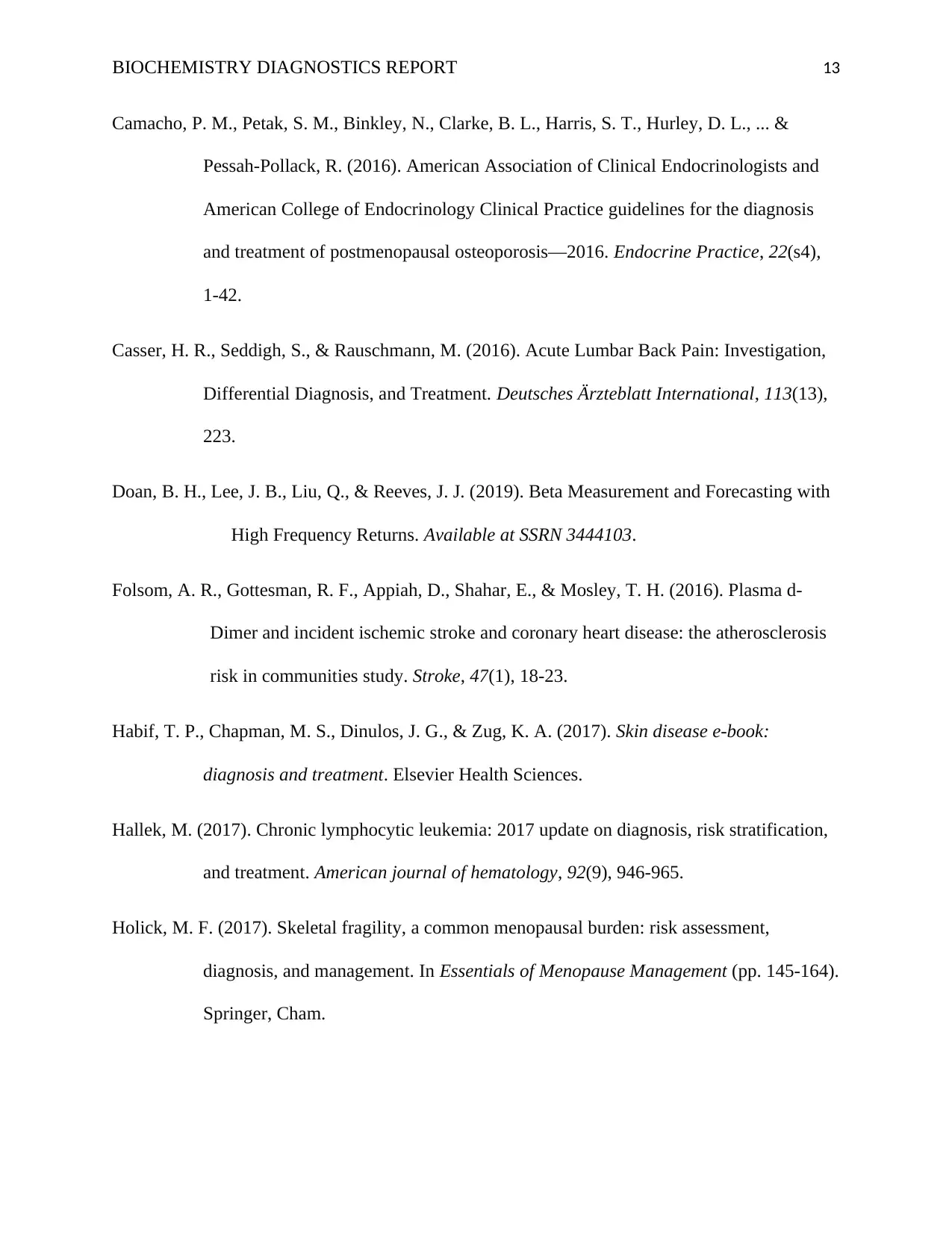
BIOCHEMISTRY DIAGNOSTICS REPORT 13
Camacho, P. M., Petak, S. M., Binkley, N., Clarke, B. L., Harris, S. T., Hurley, D. L., ... &
Pessah-Pollack, R. (2016). American Association of Clinical Endocrinologists and
American College of Endocrinology Clinical Practice guidelines for the diagnosis
and treatment of postmenopausal osteoporosis—2016. Endocrine Practice, 22(s4),
1-42.
Casser, H. R., Seddigh, S., & Rauschmann, M. (2016). Acute Lumbar Back Pain: Investigation,
Differential Diagnosis, and Treatment. Deutsches Ärzteblatt International, 113(13),
223.
Doan, B. H., Lee, J. B., Liu, Q., & Reeves, J. J. (2019). Beta Measurement and Forecasting with
High Frequency Returns. Available at SSRN 3444103.
Folsom, A. R., Gottesman, R. F., Appiah, D., Shahar, E., & Mosley, T. H. (2016). Plasma d-
Dimer and incident ischemic stroke and coronary heart disease: the atherosclerosis
risk in communities study. Stroke, 47(1), 18-23.
Habif, T. P., Chapman, M. S., Dinulos, J. G., & Zug, K. A. (2017). Skin disease e-book:
diagnosis and treatment. Elsevier Health Sciences.
Hallek, M. (2017). Chronic lymphocytic leukemia: 2017 update on diagnosis, risk stratification,
and treatment. American journal of hematology, 92(9), 946-965.
Holick, M. F. (2017). Skeletal fragility, a common menopausal burden: risk assessment,
diagnosis, and management. In Essentials of Menopause Management (pp. 145-164).
Springer, Cham.
Camacho, P. M., Petak, S. M., Binkley, N., Clarke, B. L., Harris, S. T., Hurley, D. L., ... &
Pessah-Pollack, R. (2016). American Association of Clinical Endocrinologists and
American College of Endocrinology Clinical Practice guidelines for the diagnosis
and treatment of postmenopausal osteoporosis—2016. Endocrine Practice, 22(s4),
1-42.
Casser, H. R., Seddigh, S., & Rauschmann, M. (2016). Acute Lumbar Back Pain: Investigation,
Differential Diagnosis, and Treatment. Deutsches Ärzteblatt International, 113(13),
223.
Doan, B. H., Lee, J. B., Liu, Q., & Reeves, J. J. (2019). Beta Measurement and Forecasting with
High Frequency Returns. Available at SSRN 3444103.
Folsom, A. R., Gottesman, R. F., Appiah, D., Shahar, E., & Mosley, T. H. (2016). Plasma d-
Dimer and incident ischemic stroke and coronary heart disease: the atherosclerosis
risk in communities study. Stroke, 47(1), 18-23.
Habif, T. P., Chapman, M. S., Dinulos, J. G., & Zug, K. A. (2017). Skin disease e-book:
diagnosis and treatment. Elsevier Health Sciences.
Hallek, M. (2017). Chronic lymphocytic leukemia: 2017 update on diagnosis, risk stratification,
and treatment. American journal of hematology, 92(9), 946-965.
Holick, M. F. (2017). Skeletal fragility, a common menopausal burden: risk assessment,
diagnosis, and management. In Essentials of Menopause Management (pp. 145-164).
Springer, Cham.
Paraphrase This Document
Need a fresh take? Get an instant paraphrase of this document with our AI Paraphraser
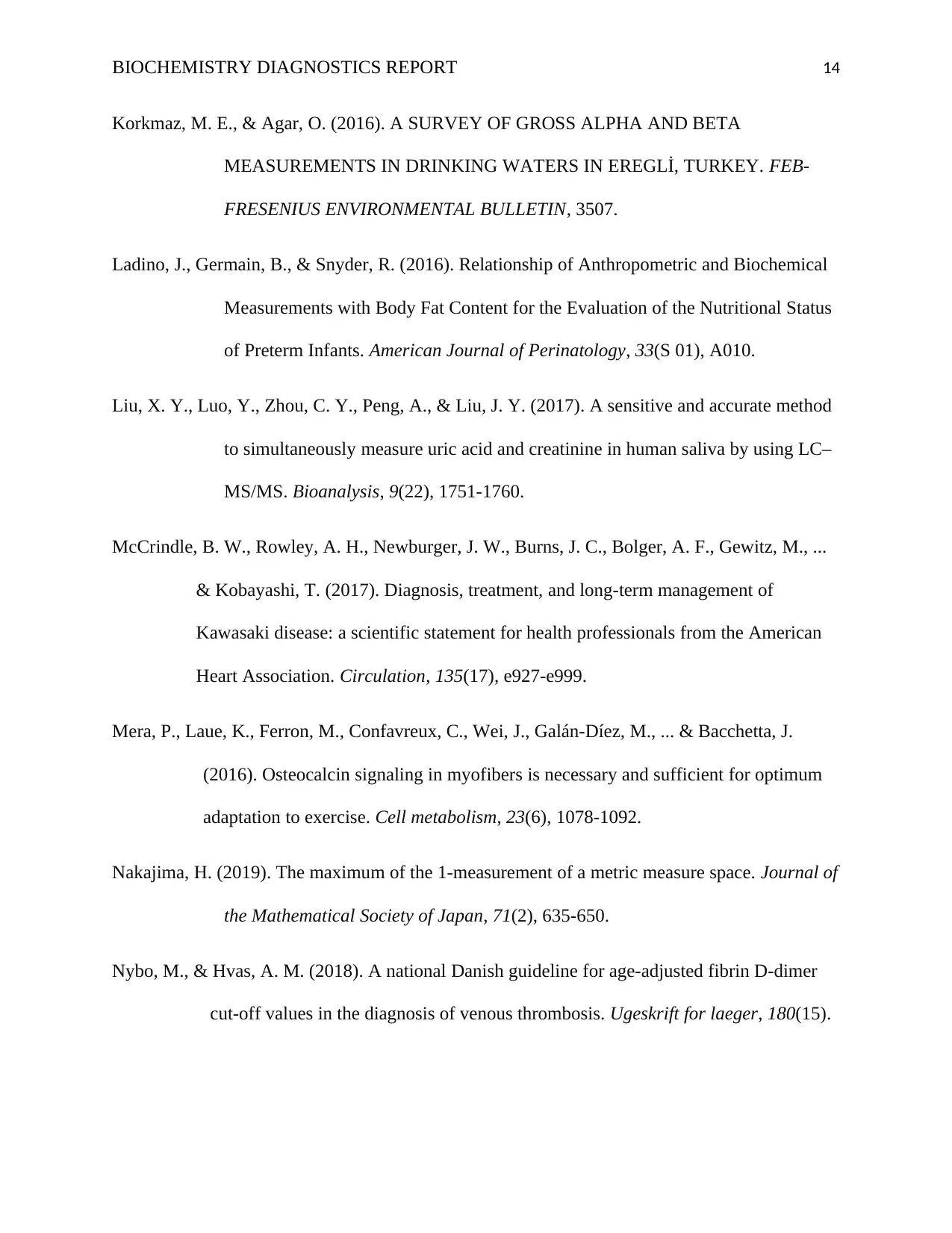
BIOCHEMISTRY DIAGNOSTICS REPORT 14
Korkmaz, M. E., & Agar, O. (2016). A SURVEY OF GROSS ALPHA AND BETA
MEASUREMENTS IN DRINKING WATERS IN EREGLİ, TURKEY. FEB-
FRESENIUS ENVIRONMENTAL BULLETIN, 3507.
Ladino, J., Germain, B., & Snyder, R. (2016). Relationship of Anthropometric and Biochemical
Measurements with Body Fat Content for the Evaluation of the Nutritional Status
of Preterm Infants. American Journal of Perinatology, 33(S 01), A010.
Liu, X. Y., Luo, Y., Zhou, C. Y., Peng, A., & Liu, J. Y. (2017). A sensitive and accurate method
to simultaneously measure uric acid and creatinine in human saliva by using LC–
MS/MS. Bioanalysis, 9(22), 1751-1760.
McCrindle, B. W., Rowley, A. H., Newburger, J. W., Burns, J. C., Bolger, A. F., Gewitz, M., ...
& Kobayashi, T. (2017). Diagnosis, treatment, and long-term management of
Kawasaki disease: a scientific statement for health professionals from the American
Heart Association. Circulation, 135(17), e927-e999.
Mera, P., Laue, K., Ferron, M., Confavreux, C., Wei, J., Galán-Díez, M., ... & Bacchetta, J.
(2016). Osteocalcin signaling in myofibers is necessary and sufficient for optimum
adaptation to exercise. Cell metabolism, 23(6), 1078-1092.
Nakajima, H. (2019). The maximum of the 1-measurement of a metric measure space. Journal of
the Mathematical Society of Japan, 71(2), 635-650.
Nybo, M., & Hvas, A. M. (2018). A national Danish guideline for age-adjusted fibrin D-dimer
cut-off values in the diagnosis of venous thrombosis. Ugeskrift for laeger, 180(15).
Korkmaz, M. E., & Agar, O. (2016). A SURVEY OF GROSS ALPHA AND BETA
MEASUREMENTS IN DRINKING WATERS IN EREGLİ, TURKEY. FEB-
FRESENIUS ENVIRONMENTAL BULLETIN, 3507.
Ladino, J., Germain, B., & Snyder, R. (2016). Relationship of Anthropometric and Biochemical
Measurements with Body Fat Content for the Evaluation of the Nutritional Status
of Preterm Infants. American Journal of Perinatology, 33(S 01), A010.
Liu, X. Y., Luo, Y., Zhou, C. Y., Peng, A., & Liu, J. Y. (2017). A sensitive and accurate method
to simultaneously measure uric acid and creatinine in human saliva by using LC–
MS/MS. Bioanalysis, 9(22), 1751-1760.
McCrindle, B. W., Rowley, A. H., Newburger, J. W., Burns, J. C., Bolger, A. F., Gewitz, M., ...
& Kobayashi, T. (2017). Diagnosis, treatment, and long-term management of
Kawasaki disease: a scientific statement for health professionals from the American
Heart Association. Circulation, 135(17), e927-e999.
Mera, P., Laue, K., Ferron, M., Confavreux, C., Wei, J., Galán-Díez, M., ... & Bacchetta, J.
(2016). Osteocalcin signaling in myofibers is necessary and sufficient for optimum
adaptation to exercise. Cell metabolism, 23(6), 1078-1092.
Nakajima, H. (2019). The maximum of the 1-measurement of a metric measure space. Journal of
the Mathematical Society of Japan, 71(2), 635-650.
Nybo, M., & Hvas, A. M. (2018). A national Danish guideline for age-adjusted fibrin D-dimer
cut-off values in the diagnosis of venous thrombosis. Ugeskrift for laeger, 180(15).
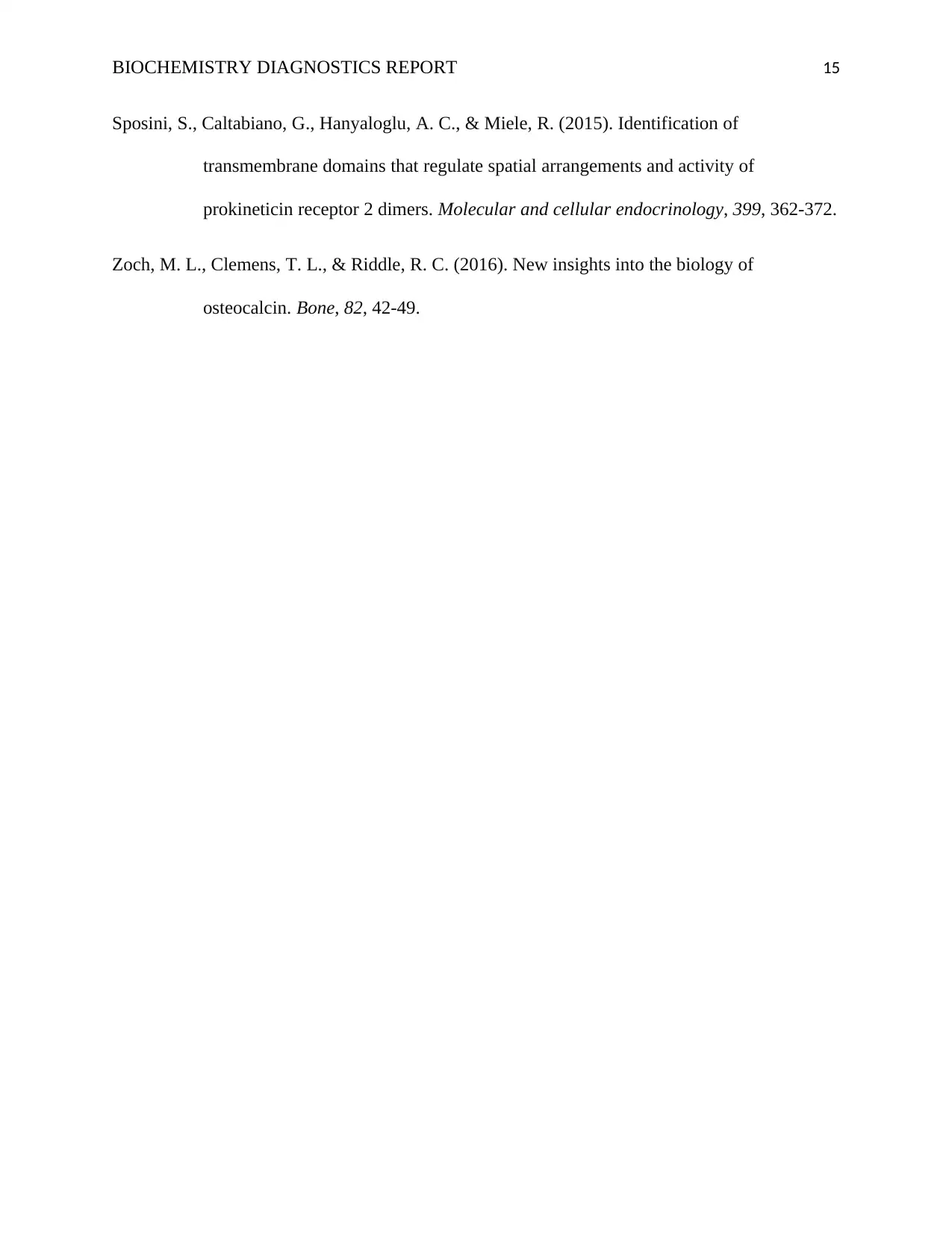
BIOCHEMISTRY DIAGNOSTICS REPORT 15
Sposini, S., Caltabiano, G., Hanyaloglu, A. C., & Miele, R. (2015). Identification of
transmembrane domains that regulate spatial arrangements and activity of
prokineticin receptor 2 dimers. Molecular and cellular endocrinology, 399, 362-372.
Zoch, M. L., Clemens, T. L., & Riddle, R. C. (2016). New insights into the biology of
osteocalcin. Bone, 82, 42-49.
Sposini, S., Caltabiano, G., Hanyaloglu, A. C., & Miele, R. (2015). Identification of
transmembrane domains that regulate spatial arrangements and activity of
prokineticin receptor 2 dimers. Molecular and cellular endocrinology, 399, 362-372.
Zoch, M. L., Clemens, T. L., & Riddle, R. C. (2016). New insights into the biology of
osteocalcin. Bone, 82, 42-49.
1 out of 15
Related Documents
Your All-in-One AI-Powered Toolkit for Academic Success.
+13062052269
info@desklib.com
Available 24*7 on WhatsApp / Email
![[object Object]](/_next/static/media/star-bottom.7253800d.svg)
Unlock your academic potential
© 2024 | Zucol Services PVT LTD | All rights reserved.





